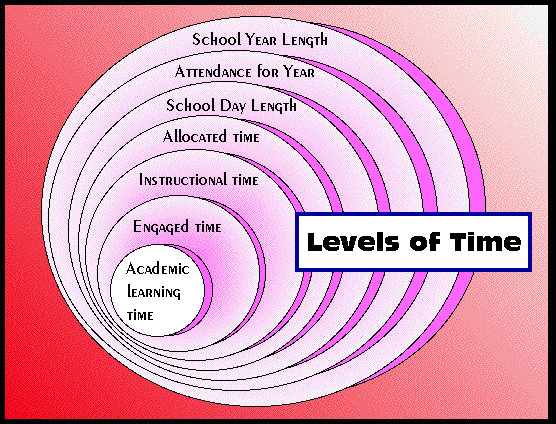
Citation: Huitt, W. (2005, April). Academic learning time. Educational Psychology Interactive. Valdosta, GA: Valdosta State University. Retrieved [date], from http://www.edpsycinteractive.org/topics/process/ALT.html
Return to | An overview of classroom processes | EdPsyc Interactive: Courses |
Academic Learning Time (ALT) is defined as "the amount of time students are successfully covering content that will be tested" (Squires, Huitt & Segars, 1983). It is a revision of the time-on-task or engaged time variable first highlighted by John Carroll (1963) in his formula for school learning (Berliner, 1990). ALT is a combination of three separate variables: Content Overlap, Involvement, and Success. Content Overlap is defined as "the percentage of the content covered on the test actually covered by students in the classroom" (Brady, et al., 1977) and is sometimes referred to as "Time on Target." Involvement is the "amount of time students are actively involved in the learning process" and is often referred to as "Time on Task." (Stallings & Kaskowitz, 1974). Success is defined as the "extent to which students accurately complete the assignments they have been given" (Fisher, et al., 1978). A high level of Academic Learning Time means that 1) students are covering important (tested/evaluated) content; 2) students are "on-task" most of the class period; and 3) students are successful on most the assignments they complete.
Because ALT is really the result of many decisions about how time is spent in schools and classroom, as is depicted in the graph below, small increases in a number of these factors can lead to large increases in ALT.
For additional discussions of academic learning time and how to improve it, see Vockell: Using time effectively: The secret to successful learning.
References:
All materials on this website [http://www.edpsycinteractive.org] are, unless otherwise stated, the property of William G. Huitt. Copyright and other intellectual property laws protect these materials. Reproduction or retransmission of the materials, in whole or in part, in any manner, without the prior written consent of the copyright holder, is a violation of copyright law.